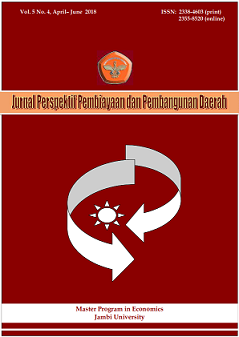The effect of distribution supply fertilizer on rice production improvement in Gorontalo City
DOI:
https://doi.org/10.22437/ppd.v5i4.5067Abstract
The purposes of this research are to: 1) analyze the distribution of subsidized fertilizer in Gorontalo City, 2) analyze the distribution of subsidized fertilizers partially (right price, right amount, and time) to increase rice production in Gorontalo City. The study conducted in Gorontalo City with a sample number of 95 farmers. The research method used is survey method. Data analysis used is multiple linear regression analysis. The results showed that there are two distributors fertilizer in Gorontalo City is PT. Indonesian Trade Company (PT PPI) and Indonesian Trade Cooperative (KPI), and 5 authorized retailers which are distributing subsidized fertilizer is Kios Tani Lestari, Anugerah Tani Kios, Saprodi Tani Kios, Cahaya Tani Kios and Bunga Tani Kios. PT. PPI is responsible for distributing NPK, SP36 and ZA fertilizers while KPI is responsible for the distribution of Urea fertilizer. Distribution of subsidized fertilizer on rice farming simultaneously have a positive and real effect on increasing rice production, while partially that have positive and real influence that is Right price, Right amount and time to increase rice production
Downloads
References
Buchari, Alma. (2007), “Manajemen Pemasaran & Pemasaran Jasaâ€. Bandung: CV. Alfabeta
Dinas Pertanian, (2017). Provinsi Gorontalo, Gorontalo
DKPP, 2017.Kota Gorontalo. Gorontalo
Gujarati, Damodaar N, (2006), “Basic Econometrics, Fourd Edition, McGraw Hill Co
Khairunisya, (2009),“Efektifitas Penyaluran Pupuk Bersubsidi Bagi Petani Padi Di Kabupaten Lampung Tengah†(Studi Kasus : Lini IV Kecamatan Trimurjo).
Ogheneruemu, OBI-EGBEDI. Abdul Hameed, BANKOLE Olaide. (2017). Determinants of Participation in Fertilizer Subsidy Programme Among Rice Farmers in Ogun State, Nigeria. Journal of Development and Agriculturan Economics Vol. 9 (6), pp, 162-167, June 2017
Permenpan, (2016). Jakarta
Rini Desi Puspo. (2006). Analisis Pengaruh Pupuk Bersubsidi Terhadap Kinerja Industri Pupuk di Indonesia. Tesis.Fakultas Ekonomi Dan Manajemen Institut Pertanian Bogor. Bogor.
Rodrigo, Chatura. Abeysekera, lakmal. (2015). Why The Fertilizer Subsidy Should Be Removed: key Factors That Actually Derive The Fertilizer Demand in Paddy Sector of Sri Lanka. Sri Lanka Journal of Economic Research Volume 3 (2) December 2015: 71-98. Sri Lanka Forum of University Economists
Saweda O, Lenis, barret, Christopher B, and Sheahan Meghan. (2014). Understanding Fertilizer For Rice Production Across Nigeria’s Diverse Agro Ecological Conditions. http//www.worldbank.org/. Annual Bank Conference onAfrica,June 23th – 24th 2014
Soekartawi. (2006). Analisis Usahatani. Penerbit Universitas Indonesia, Jakarta.
Sudjana. (2002). Metode Statistika. Penerbit PT Tarsito. Bandung
Sugiyono. (2014). Metode Penelitian Kuantitatif, Kualitatif dan R&D. Cetakan ketujuhbelas. Penebar ALFABETA,CV. Bandung.
Wijetunga, Chatura. Saito, Katsuhiro. (2017) Evaluating The Fertilizer Subsidy Reforms in The Rice Production Sector in Sri Lanka: A Simulation Analysis. Advances In Management & Applied Economics, Vol. 7, No. 1, 2017, 31-51
Winardi. (2005). “Strategi Pemasaran†(Marketing Strategi). Bandung: Mandar Maju
Downloads
Published
How to Cite
Issue
Section
License
Copyright (c) 2018 Amir Halid, Heldy Vanni Alam, Mohamad Hamdi H. Payuyu

This work is licensed under a Creative Commons Attribution 4.0 International License.

















